Caring for mini bonsai trees seems to be difficult but there are only six things you should consider:
- placing
- watering
- fertilizing
- repotting
- controlling pests and insects, and
- caring in extreme weather.
Here is the detailed guide for taking care of your mini bonsai trees.
Placing
Mini bonsai trees should be kept in the place;
- with plenty of direct sunlight
- with fresh air and enough airflow
- where they could be cared for easily, and
- away from railroads and big roads.
Plenty of sunlight

Common bonsai species such as juniper, jade, oak, maple and cherry are photophilic plants; i.e. plants that grow in open places and cannot withstand a long period of time in the shade.
Photophilic plants like common mini bonsai trees need on average 35,000 to 40,000 lux of light density, which is normally attainable only by keeping them outside.
If you want to keep them inside the house, place them where they get at least 3 hours of sunlight a day such as alongside the window or on the balcony.
For more detailed information, please refer to the following post.
Abundant fresh air
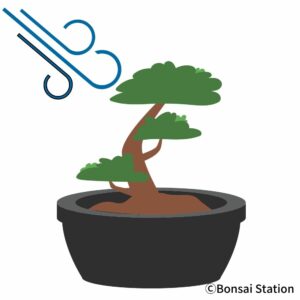
For photosynthesis
For plants’ photosynthesis, carbon dioxide in the air is necessary to convert into various organic chemicals which are used to grow and store energy. This means they need a constant supply of new carbon dioxide coming into their growing space, Without moving air, carbon dioxide can be rapidly removed from the surrounding air by photosynthesis.
For roots respiration
Plant roots respirate. Roots need oxygen to burn carbohydrates for the energy to grow and repair. In fact, the main purposes of the drainage holes in the bonsai pot are to prevent the tree from drowning in water and help the soil aerate.
For more detailed information, please refer to the following post.
On the shelf

Mini bonsai trees should be kept where they can be cared for easily, preferably on the shelves.
Shelving specifications
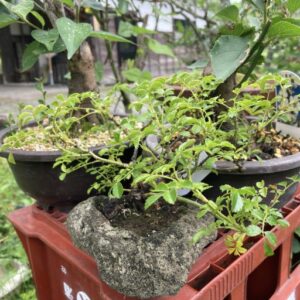
Height
The height of the shelves should be (1) below the level of your eyesight so that you can watch the trees from every angle and (2) the one you can water, fertilize, move and care for easily.
Material
The material is preferably wood or stone because they do not absorb heat and cold. Metal shelves are not desirable as they reflect too much sunlight in summer and become too cold in winter which can damage the tree.
Shape
Each shelf should have some kind of edge so that the trees would not fall from them by the wind or heavy rain.
Placing on the ground
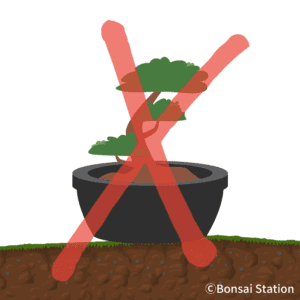
Placing mini bonsai trees directly on the ground is not desirable because of the following reasons;
- not enough sunlight or too much radiant heat
- not enough airflow
- leads to uneven growth
- can be infested with bugs and pests
- roots growing out of the drainage holes into the ground, and
- unable to observe from every angle.
Away from railroads and big roads

Placing mini bonsai trees away from railroads and big roads is necessary because loud noises and tiny tremors by trains and cars are stressful to them.
Mini bonsai trees, like other plants, do not like when leaves and branches touch each other constantly. It is stressful to them and their defense mechanism turns on, releasing a plant hormone called ethylene.
This defense mechanism also works when an insect lands on a plant, where genes are activated preparing the plant to defend itself against being eaten.
Watering

The frequency of watering your mini bonsai tree depends on several factors as follows:
- Frequency of the rain in the region,
- Temperature,
- Amount of sunlight,
- Age of the tree (the younger, the more water),
- Species of the tree (flower and fruit bonsai need more water than coniferous bonsai), and,
- When it is last repotted (the longer, the more water retention due to the development of the roots).

The general rule of watering a mini bonsai is
- Once a day in spring and fall,
- Twice a day in summer, and,
- Once every three days in winter.
But this general rule should be altered depending on the factors mentioned above. You need to observe your mini bonsai tree carefully and water them when the soil is half dry. You can touch the surface of the soil (if it is not covered with moss) to check the soil moisture.
For more details on watering, please refer to the following post.
Fertilizing
Why fertilizing mini bonsai trees is necessary
All mini bonsai trees are planted in tiny pots with very little soil. This soil is almost fertilizer-free in order to attain good drainage and aeration, so the nutrients that the trees need to be added afterward.
Without fertilizer, mini bonsai trees will quickly absorb all of the very small amounts of nutrients in the soil and eventually weaken.
Fertilizing an adequate amount is important
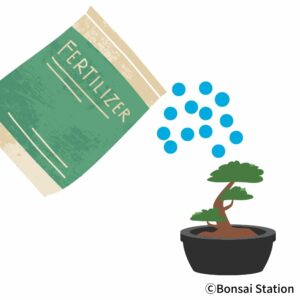
If too little fertilizer is used, mini bonsai trees will not grow well. The new branches will be lean and elongated, and the trunk will become thinner. They may not flower or bear fruits.
On the other hand, too much fertilizer may cause the branches and the leaves to excessively grow, which impairs the style of the tree. Over-fertilization may also rot the roots.
It is thus necessary to pay attention to the type, timing, concentration and frequency of fertilization.
When to fertilize

When to fertilize depends on the mini bonsai species as well as the stage of the tree growth. In general, the best seasons for fertilizing are spring and fall when the mini bonsai trees are growing.
Fertilizing in summer should be avoided as additional nutrients on top of plenty of summer sunlight may cause an overgrowth of branches and leaves. Most of the mini bonsai trees are dormant in winter so no fertilization is needed during this season.
How much to fertilize
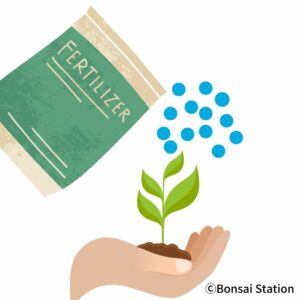
How much to fertilize also depends on the mini bonsai species as well as the stage of the tree growth.
Young trees in the tailoring stage require a lot of nutrients for growth. As the trees grow older, less fertilizer is required.
Tree species that generally need fertilizer include fruit and flower bonsai trees, as well as deciduous trees. Typical tree species that do not require much fertilizer are coniferous trees such as black and red pine that grow in rocky/sandy areas with poor nutrients.
When to avoid fertilizing
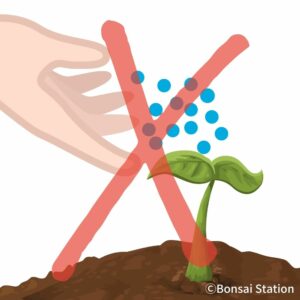
There are timings to avoid fertilizing mini bonsai trees such as;
- just after repotting
- during winter and summer
- during the formation of flower buds (usually summer) and
- during rainy season, if any.
Just after repotting
The roots are damaged by pruning and the tree vigor is weak just after repotting. Fertilizing mini bonsai trees in a weak state can actually damage them, not strengthen them. This is like humans; we do not want rich food when we are sick.
In principle, fertilize the tree when the new rooting is certain, which is about one month after repotting.
Winter/summer
Bonsai trees do not need fertilization during the winter when they are dormant.
In summer, all mini bonsai the trees need is plenty of sunlight for nutrients. The growth itself is not so robust compared to spring and nutrient absorption during summer is relatively low.
During formation of flower buds
If the fertilizer is applied to flower bonsai trees during the flower bud formation, the kind of buds that grow to be branches and leaves will tend to grow vigorously, suppressing the formation of the flower buds. Fertilization at this time will lead to fewer flowers, as well as flowers with bad color and shape.
During rainy season (if any)
If you live in a region with long rainy days, avoid fertilization in this season as the fertilizer will flow out with the rain. Also, the combination of abundant water and nutrients will likely cause elonged and odd branches to grow.
Repotting
Why repotting is necessary
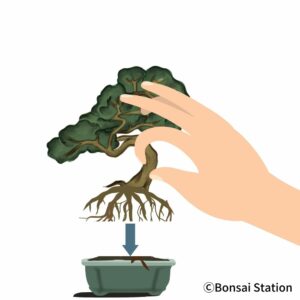
The purpose of repotting mini bonsai trees is to facilitate the growth of new roots by pruning old ones and to change soil.
When the roots fill the pot, the soil becomes less breathable and drainable. This is a life-threatening event for mini bonsai trees living in tiny pots. The purpose of repotting is to prevent root clotting and rotting, and to promote growth by changing to new soil.
The roots of deciduous trees would fill the pot in one year. The roots of coniferous trees, whose roots grow slowly, would fill the pot in about three years. When the roots fill the pots fully, the amount of fertilizer in the soil is also low. The absorption of nutrients and water is also poor since the roots are intertwined.
When the roots work poorly, the branches and leaves lose their energy and the style of the tree is impaired.
Roots and branches
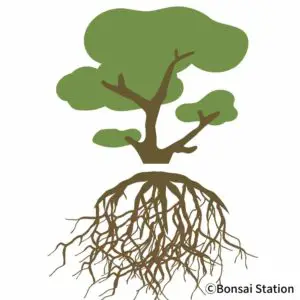
There is a close relationship between the roots and the branches. If there are numerous fine roots, the branches grow well.
But if there are only a few and thick roots, the branches do not grow well. This happens when the pot is full of roots as the roots compete with each other for nutrients and water, and the surviving roots grow thicker and thicker.
When the fine roots disappear and only a few thick roots grow, the effect appears on the branches; only a few branches grow vigorously, and the other branches gradually weaken.
So, it is important to cut the overgrown roots when repotting. By pruning the old roots, new fine roots start to grow from the cut. The tree will rejuvenate and the style of the tree can be maintained.
When to repot
In general, the best seasons for repotting are early spring and fall.
- Deciduous trees: early spring before new sprouts/ late fall
- Flower/fruit trees: early spring before new sprouts
- Coniferous trees: early spring before new sprouts/ early fall
Frequency of repotting
- Deciduous/ flower/fruit trees: every 1-2 years
- Coniferous trees: every 3-4 years
For more details on how to repot, please refer to the following post.
Controlling pests & insects
Mini bonsai trees and pests/insects

Species prone to pests/insects
Tree species that are relatively prone to pests and insects include deciduous trees with soft leaf tissues as well as fruit/flower bonsai species. Once they become sick, they are more difficult to recover and could die off.
Species disinclined to pests/insects
Some bonsai tree species such as coniferous trees are relatively resistant to pests and insects. Even if they are infested, they tend to recover quickly and it is rarely fatal for them. However, new spouts can be infested even for these types of trees.
How insects injure mini bonsai
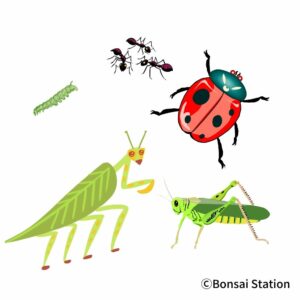
Insects may feed on leaves, stems, roots, and flowers. There are two types of insects; chewing and sucking insects.
The chewing insects consume the infested parts. Types of leaf-feeding by chewing insects include beetles and young caterpillars.
Sucking insects remove or sap cells and thereby weaken the trees. Some of these sucking insects inject saliva into the trees. This secretion may (1) kill the tree, (2) cause galls to form or (3) kill portions of a leaf.
Insertion of sucking mouthparts into plants also increases potential for the transmission of plant diseases. Preventing the transmission of viruses can be the chief reason to control certain insects.
How to prevent pests and insects
To prevent mini bonsai trees from pests and insects, you should;
- keep the tree healthy
- prune the tree at the right time
- protect existing trees when you buy a new one, and
- use insecticide/ pesticide regularly.
Keep the tree healthy

On a daily basis
Pests and diseases are more likely to attack weak trees. In order to maintain mini bonsai’s health on a daily basis, place the trees in the right spot with plenty of sunlight and airflow, as discussed earlier in this post.
Also,
- Repot regularly to keep adequate drainage and aeration;
- Fertilize adequately for optimal health; and
- Observe the tree from every angle to inspect the infestation regularly.
Prune the tree at the right time
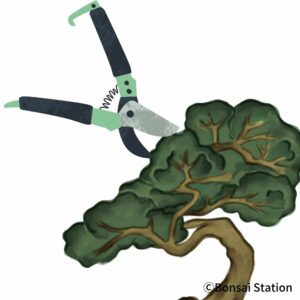
Pruning is a necessary process of making and maintaining the style of a mini bonsai tree but it can induce pests and diseases by wounding the tree. So the timing and the methods of pruning are important to protect it from infestation.
Optimal time for pruning
In general, the optimal pruning time for insect- or disease-prone bonsai species is winter, just before spring, when temperatures and infection rates are lower.
The speed of recuperation from pruning is greatly affected by developmental conditions, vigor and health of the tree. A healthy tree will seal wounds faster and the same for younger trees as well.
Keep in mind that the trees that are planted in well-drained, quality soils with good texture and adequate nutrition levels grow in a way that favors the healing process.
Methods of pruning
Using dedicated tools for each of the pruning processes makes less damage to your mini bonsai trees than using garden-variety scissors.
Use a knob cutter (concave branch cutter) to make clean cuts when removing larger branches. The wounds may not heal well if the tissues are crushed with a dull blade. Straight cuts leave smaller wounds than angled cuts, and smaller wounds are more likely to callus over promptly.
Make sure to sterilize the tools before pruning by washing them thoroughly. This can help reduce the transmission of plant diseases spreading to healthy trees.
Do not use wound dressing
Despite the common myths, covering wounds with traditional petroleum-based sealants actually inhibits bonsai trees’ healing process. The trees need oxygen around wounded tissues to form a callus and so limiting oxygen availability should be avoided. In fact, research indicates any type of wound dressing can slow the healing process.
If you must, a light coating of an insecticide or fungicide may be a good idea, especially if you have to prune in the warmer season when insects and fungi are active.
Protect from new trees

Before you buy a new mini bonsai tree from a shop, observe the condition of the trunk, leaves and roots carefully, and make sure to choose a healthy one without pests and insects. After bringing it home, place it away from your existing mini bonsai trees for a few days for quarantine, if you can.
If the season permits, repot the new one as soon as possible. Pathogens and insects (including their eggs) could be hidden in the soil that may infect other trees.
Use pesticides/insecticides regularly
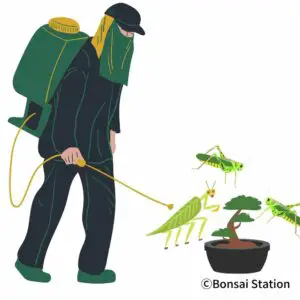
Use pesticides or insecticides regularly for prevention regardless of the infestation.
The frequency of spraying depends on the type of the bonsai tree as well as the pesticides/ insecticides. Read the label carefully and use it in the right concentration and frequency.
The spraying may also depend on the season; you may have to spray more frequently in the warmer season when pests and insects are more likely to occur. Insects are not active in the colder weather but pathogens may occur if you keep your mini bonsai trees in a greenhouse.
Caring in extreme weather
Special winter care

The degree of mini bonsai trees’ cold resistance depends on;
- species
- age and
- wild/horticultural
Mini bonsai trees from warm climates like ficus have less resistance to cold as species. In general, seedlings/ young trees, as well as horticultural species, cannot survive well in the cold weather compared to full-grown and wild species.
Apart from placing the trees in the greenhouse, the following could be done to prevent them from dying in the winter.
- Put the mini bonsai pots in a box
- Bury the mini bonsai pots in the ground
- Prevent cold and dry wind, and
- Prevent frost using plant cover.
Put the mini bonsai pots in a box

Putting mini bonsai trees in a box can prevent the roots to freeze. The box should be as high as the height of the pots. The spaces among pots could be filled with pumice or vermiculite for more insulation. Aldo, the top of the soil could be covered with a layer of mulch for more protection.
Bury the bonsai pots in the ground
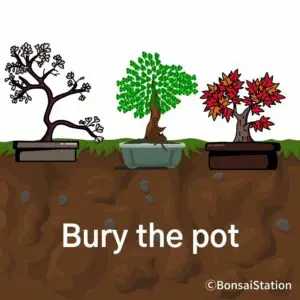
You can also bury the pots in the ground with a soil with good drainage. The pots should be buried at the height of the pots. Make sure to water your trees at the same frequency as they are on the shelves because your trees cannot absorb water from the ground well through the small drainage holes in the pots.
Prevent cold and dry wind
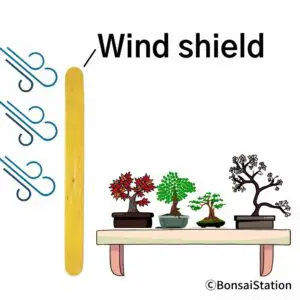
Cold and dry wind can damage your mini bonsai trees as much as the temperature drop because they freeze leaves and overdry the trees. Make a windshield from the angle the wind is blowing in the winter without blocking the sunlight.
Prevent frost
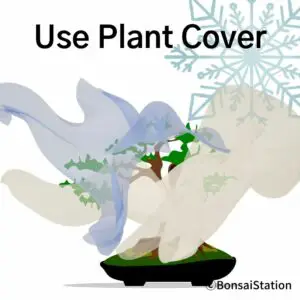
You can use plant cover like cheesecloth to cover the trees very loosely to prevent frost. The top of the soil could be covered with a layer of mulch as well.
Special summer care

Preventing water shortage
Summer could be a tricky season for a mini bonsai tree as the pot holds a very little amount of soil and it could dry out quickly.
Soil tends to dry out fast in summer because;
- of strong sunlight
- of hot wind and
- mini bonsai trees absorbs lots of water in this season.

To prevent this, you can use a box filled with river sand and bury the bottom of the pots in it.
Type of the box

The material of the box could be anything from wood to plastic. Anything you can find at home which can hold river sand, as well as your mini bonsai trees, will do. You might have to move the box from time to time so a box with handles or something that you can move easily is a good choice.
Preferably, it is good to have some kind of holes at the bottom to drain water. Without drainage holes, the box could be flooded with water when it rains heavily.
Height of the box

The height of the box should be below the pots’ height so that the soil can dry with wind and sunlight at the same time as it retains water. Too much water could stretch out the branches and impair the style of the mini bonsai trees.
Type of the river sand

Fuji sand
The type of river sand in the box could be anything that you can find at home or in gardening shops. You can also use perlite or vermiculite if they are readily available to you. Use something that holds water adequately but drains it sufficiently as well.
Remember to pick up the bonsai pots from the box from time to time to check whether the roots are not coming out of the pots’ drainage holes into the river sand. If they do, cut them out.
Preventing strong sunlight
Strong sunlight in the summer could be harmful to some deciduous species such as maple trees. Move those trees under a shade or cover them in the afternoon when the sun is high, after having a few hours of sunlight in the morning.
—–
Reference:
“Tree wounds and healing”. Purdue University Forestry & Natural Resources. (link here)
“Insects and their injury to plants”. The Connecticut Agricultural Experiment Station, Connecticut State. (link here)



